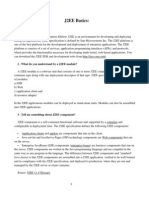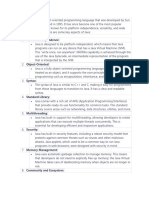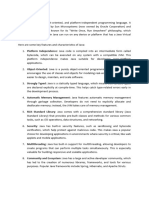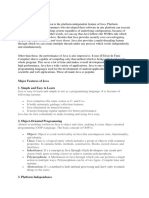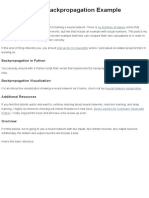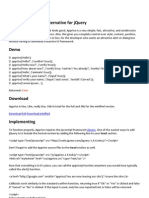0 ratings0% found this document useful (0 votes)
3 viewsIntroduction to Java
Java is a class-based, object-oriented programming language designed for portability and ease of use, allowing developers to write code once and run it anywhere. Key features include platform independence, strong typing, automatic memory management, and robust security measures. The Java Runtime Environment (JRE) and Java Virtual Machine (JVM) are essential components that enable Java applications to run across various platforms while providing necessary libraries and performance optimizations.
Uploaded by
kunwar.chawlaCopyright
© © All Rights Reserved
We take content rights seriously. If you suspect this is your content, claim it here.
Available Formats
Download as PDF, TXT or read online on Scribd
0 ratings0% found this document useful (0 votes)
3 viewsIntroduction to Java
Java is a class-based, object-oriented programming language designed for portability and ease of use, allowing developers to write code once and run it anywhere. Key features include platform independence, strong typing, automatic memory management, and robust security measures. The Java Runtime Environment (JRE) and Java Virtual Machine (JVM) are essential components that enable Java applications to run across various platforms while providing necessary libraries and performance optimizations.
Uploaded by
kunwar.chawlaCopyright
© © All Rights Reserved
We take content rights seriously. If you suspect this is your content, claim it here.
Available Formats
Download as PDF, TXT or read online on Scribd
You are on page 1/ 5
Introduction to Java
Java is a class-based, object-oriented programming language that is
designed to have as few implementation dependencies as possible. It
is intended to let application developers write once, and run anywhere
(WORA), meaning that compiled Java code can run on all platforms
that support Java without the need for recompilation. Java was first
released in 1995 and is widely used for developing applications for
desktop, web, and mobile devices. Java is known for its simplicity,
robustness, and security features, making it a popular choice for
enterprise-level applications.
Java was developed by James Gosling at Sun Microsystems Inc in May
1995 and later acquired by Oracle Corporation. It is a simple
programming language. Java makes writing, compiling, and debugging
programming easy. It helps to create reusable code and modular
programs. Java is a class-based, object-oriented programming
language and is designed to have as few implementation
dependencies as possible. A general-purpose programming language
made for developers to write once run anywhere that is compiled Java
code can run on all platforms that support Java. Java applications are
compiled to byte code that can run on any Java Virtual Machine. The
syntax of Java is similar to C/C++.
Features of Java
The primary objective of Java programming language creation was to
make it portable, simple and secure programming language. Apart
from this, there are also some excellent features which play an
important role in the popularity of this language. The features of Java
are also known as Java buzzwords.
A list of the most important features of the Java language is given
below.
❖ Platform Independence: Java code is compiled into bytecode,
which can run on any device that has a Java Virtual Machine
(JVM). This "write once, run anywhere" capability makes Java
highly portable.
❖ Object-Oriented: Java is built on the principles of object-
oriented programming (OOP), which promotes code reuse and
modularity. It uses concepts like inheritance, encapsulation,
polymorphism, and abstraction.
❖ Strongly Typed: Java enforces strict type checking, which helps
catch errors at compile time. This reduces runtime errors and
improves code reliability.
❖ Automatic Memory Management: Java has a built-in
garbage collection mechanism that automatically manages
memory allocation and deallocation, helping to prevent memory
leaks.
❖ Multithreading Support: Java provides built-in support for
multithreading, allowing developers to write programs that can
perform multiple tasks simultaneously, improving performance
and responsiveness.
❖ Rich Standard Library: Java comes with a comprehensive
standard library (Java Standard Edition API) that provides a wide
range of pre-built classes and methods for tasks such as data
structures, networking, and file handling.
❖ Security Features: Java has a strong security model that
includes features like the Java sandbox, bytecode verification,
and a robust API for cryptography, helping to protect applications
from security threats.
❖ High Performance: While Java is an interpreted language, the
Just-In-Time (JIT) compiler enhances performance by compiling
bytecode into native machine code at runtime.
❖ Robustness: Java emphasizes strong error handling and type
checking, making it easier to develop reliable and stable
applications.
❖ Dynamic: Java is designed to be dynamic, allowing for the
extension of applications at runtime and the ability to load
classes dynamically.
Java Virtual Machine (JVM)
The Java Virtual Machine (JVM) is a crucial component of the Java
Runtime Environment (JRE) that enables Java applications to run on
any device or operating system without requiring modifications. Here
are some key points about the JVM:
❖ Platform Independence: The JVM allows Java programs to be
executed on any platform that has a compatible JVM, promoting
the "write once, run anywhere" philosophy.
❖ Bytecode Execution: When Java source code is compiled, it is
converted into bytecode, which is a platform-independent code.
The JVM interprets or compiles this bytecode into machine code
for execution on the host system.
❖ Memory Management: The JVM handles memory allocation
and garbage collection, freeing developers from manual memory
management and helping to prevent memory leaks.
❖ Security: The JVM includes a security manager that enforces
access controls and provides a secure execution environment,
especially important for running untrusted code (like applets).
❖ Performance Optimization: Modern JVMs include Just-In-
Time (JIT) compilers, which improve performance by compiling
bytecode to native machine code at runtime, optimizing
execution speed.
❖ Multiple Implementations: There are various
implementations of the JVM, including Oracle's HotSpot,
OpenJ9, and GraalVM, each with unique features and
optimizations.
Java Runtime Environment
(JRE)
The Java Runtime Environment (JRE) is a part of the Java Development
Kit (JDK) and provides the necessary libraries and components to run
Java applications. Here are the main features and components of the
JRE:
❖ Java Virtual Machine (JVM): The core of the JRE, the JVM is
responsible for executing Java bytecode. It provides an
environment where Java programs can run, regardless of the
underlying hardware and operating system.
❖ Java Class Libraries: The JRE includes a set of standard libraries
(Java API) that provide essential functions and features, such as
data structures, networking, file handling, and graphical user
interface (GUI) components.
❖ Java Plug-in: This component enables the execution of Java
applets in web browsers, allowing users to run Java applications
embedded in web pages.
❖ Deployment Technologies: The JRE supports various
deployment technologies, such as Java Web Start, which allows
users to launch Java applications directly from a web browser.
❖ Security Features: The JRE includes a security manager and a
class loader that help ensure safe execution of Java applications
by enforcing access controls and managing permissions.
❖ Platform Independence: By providing a consistent runtime
environment across different operating systems, the JRE allows
Java applications to be portable and run anywhere without
modification.
You might also like
- Understanding CSV and Json Files: Pytho NNo ratings yetUnderstanding CSV and Json Files: Pytho N13 pages
- Object Oriented Techniques Unit 4 & 5 By Dr. Choudhary Ravi SinghNo ratings yetObject Oriented Techniques Unit 4 & 5 By Dr. Choudhary Ravi Singh62 pages
- Chapter 1 - Introduction To Java LanguageNo ratings yetChapter 1 - Introduction To Java Language14 pages
- Day 3_ Part 1- History and Evolution of JavaNo ratings yetDay 3_ Part 1- History and Evolution of Java7 pages
- Java Basics : Your Comprehensive Guide to Programming with Ease and Confidence from Scratch to Advanced ConceptsFrom EverandJava Basics : Your Comprehensive Guide to Programming with Ease and Confidence from Scratch to Advanced ConceptsNo ratings yet
- Wepik Unraveling The Wonders of Java A Comprehensive Guide 20231106101829jKUrNo ratings yetWepik Unraveling The Wonders of Java A Comprehensive Guide 20231106101829jKUr106 pages
- BCA TDC III BASIC OF JAVA by Dr. Rakesh RanjanNo ratings yetBCA TDC III BASIC OF JAVA by Dr. Rakesh Ranjan6 pages
- Core Java Notes: Chapter-1, 2,3 Features of JAVA EnvironmentNo ratings yetCore Java Notes: Chapter-1, 2,3 Features of JAVA Environment31 pages
- Medium Com Omarelgabrys Blog Microservices With Spring Boot Authentication With JWT Part 3 Fafc9d7187e8No ratings yetMedium Com Omarelgabrys Blog Microservices With Spring Boot Authentication With JWT Part 3 Fafc9d7187e819 pages
- Github Com Suryakant Bharti Important Java Concepts Tree MasNo ratings yetGithub Com Suryakant Bharti Important Java Concepts Tree Mas9 pages
- A Step by Step Backpropagation Example - Matt MazurNo ratings yetA Step by Step Backpropagation Example - Matt Mazur7 pages
- Chapter 1: Introduction To Computers, Programs, and Java Objectives100% (1)Chapter 1: Introduction To Computers, Programs, and Java Objectives12 pages

